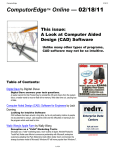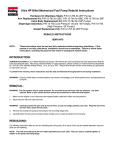Transcript
techbench JOHN HINCKLEY Got a question for John? E-mail him at [email protected]. Reader’s Question: My ’66 327/350 was fairly correct when I bought it several years ago, but it had a Holley, model 1850, universal replacement carburetor on it instead of the original R-3367. I’ve recently purchased a correctly dated original Holley R-3367 and installed it along with the choke thermostat coil and rod, but I’m having a problem adjusting the fast idle speed. It works with the engine cold and the choke blade closed, but it only kicks up the idle to about 1200 rpm at cold start, and that isn’t always enough to keep it running without feathering the throttle for the first few seconds. The old 1850 had a screw to adjust the fast idle, but I don’t find one on the R-3367. How do I increase the fast-idle speed? RESPONSE: The fast-idle control principle is similar between the two carburetors (a pivoting plastic stepped cam operated by the rod from the choke thermostatic coil on the intake manifold that engages a tang on the primary throttle lever), but the detail design is a little different on the production Holleys. The photos show how the choke/fast idle system works on the 3367. You’ll notice the plastic fast-idle cam pivoted all the way down (normal warm idle position), with the tang on the throttle lever above the top of the disengaged cam. In this mode, idle rpm is controlled by the idle-speed screw in the primary throttle lever on the other side of the carburetor. At cold start, when you press the accelerator to set the choke, the rod from the thermostatic coil (not shown in the photo) pushes up on the lever in the foreground, which pivots the plastic cam up (and closes the choke butterfly), and when your foot comes off the accelerator, the tang (with the slot in it) on the primary throttle lever comes to rest on one of the raised steps on the fast-idle cam. The amount the plastic cam is raised (and thus, the height of each fast-idle step on the cam the tang comes to rest on) is determined by the temperature of the choke thermostatic coil. There is no fast-idle adjustment screw on the R-3367. To adjust it, insert a flat-bladed screwdriver through the slot in the tang that contacts the steps on the cam and bend it slightly clockwise (as viewed from the top) to increase rpm at any given step on the cam, or bend it slightly counterclockwise to reduce rpm. Assuming your choke unloader and choke vacuum break are adjusted properly as outlined in the Chassis Overhaul Manual and the choke thermostat coil operating rod length is adjusted as outlined in the Chassis Service Manual, the 88 CORVETTE ENTHUSIAST 1 2 3 1 The greenish-hued plastic fast-idle cam (behind the choke operating lever in the foreground) is pivoted all the way down with the engine warm, and the tang on the primary throttle lever is clear of the top of the cam. 2 With a cold engine, the plastic cam pivots upward, and the tang on the primary throttle lever is now resting on one of the raised steps of the cam. This opens the primary throttle blades and increases idle speed. 3 To adjust the fast-idle speed, insert a flat-bladed screwdriver in the slot in the tang. Bend clockwise to increase, counter-clockwise to decrease. automatic choke is pretty trouble-free, and the fast-idle rpm adjustment is quite simple, as outlined above. Proper operation of the fast-idle system with a cold engine is one of the line items checked in the Operations section of NCRS Flight Judging. It pays to have it “spot-on”!







